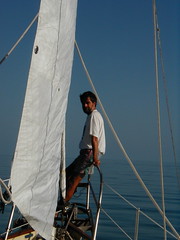Parts list, costs and other thoughts! - rebuilding our Volvo MD
11D engine!
The engine appears to be running fine, at least for the last 20
minutes or so, and while the boat is still resting on land. Our “dear” friend Peter (Aquataurus) insisted
that the real test will be when we put the engine under load …. Thanks Peter
for your vote of confidence!!!!
Which parts did I need:
Here is a listing of all the parts I had ordered and installed
during this overhaul.
- Cylinder Liner Kit # 875549 (liner and pistons and
sealing rings and piston ring)
- Decarbonizing Kit 876376
- Push Rod 3583802
- Paint for engine
Costs:
While I found the detailed listing by http://www.marinepartseurope.com/en/e-volvo-penta-603-MD11D.aspx
very helpfull, their listings gave me also a good idea about the costs
involved in rebuilding this engine. In the end, I obtained my parts from the
“local” Volvo distributor (http://www.frenchcreekmarina.com/). Apart from getting some valuable advice from
the marina staff, their prices were also significantly less than
those found at the above mentioned site.
In total, and including the re-grinding of the valves and its
seats, we paid about $1,600 for all what we needed so far for our rebuild.
Other thoughts and considerations:
We are (occasionally long-range) cruisers, and because of this we
enjoy certain features of this engine.
It has hand-starting capabilities (in case the battery should fail), it
does not rely on sophisticated electronic controls, and it offers the
possibility to rebuild the engine in situ due to its replaceable wet-type
cylinder liners and side access ports.
When our engine showed severe signs of aging, we had the option (A) to replace it with a
more modern engine, (B) to purchase an overhauled engine of the same type (or
to have the work done on our engine), or (C) try to learn how to rebuild this engine on our
own.
Option A and B amounted pretty much to the same dollar amounts re engine,
apart for the additional costs involved for Option A concerning shaft
couplings, changing engine beds, moving controls and hoses …. friends of ours
who followed this route spent about the same amount on all these changes as on
the engine itself.
Option C – if it would have failed, we could always go back to
option A and B. We knew the approximate
costs of this risk. And should we be
successful, we would have saved a good deal of money – and learned a lot in the
process!
And apart from our cost calculations, I can say that I have now a much better
idea about the engine and how to repair it, and would not hesitate to take on
this job once again.
If !!! … yeah, always so easy to say after the fact. Back in Martinique , we
contemplated to replace the engine. We
had ongoing problems which we found difficult to trace (especially cooling
issues with repeatedly broken impellers, apart from some other issues), causing
us a considerable amount of stress.
Enough stress that we were ready to look into purchasing/installing
another engine; the infra-structure in Martinique
would have allowed us to do that right there.
Fortunately, we met Frank from SV Enola who knew this engine and who explained the likely
cause for these symptoms and suggested a “temporary” solution (rinsing the
cooling passages with HCL), but made it clear that we would have to take the
engine apart to do a proper job. The
rinsing helped and the engine stopped overheating or eating its impellers.
If I would have had access to similar information I provided
in my blog, I would have done an overhaul. Alas,
I had much less information available to me at that time and did not see myself
taking the engine apart as per workshop manual. Calder's book on diesel engine repair suggested on-bord solutions, and showed tentalizing images. But his instructions were not detailed enough for me to follow through with a rebuild past decarbonization. And I did not know at that time about the article written by Manfred (http://www.kavenga-segeln.de/media/2b574205c78c63f8ffff893aac144227.pdf) whose images suggested that a rebuild can indeed be carried out with the engine bed/crankcase remaining on the boat and the piston rods remaining in place. That article got me thinking ...
In the end, to do a job like this in these places, one would have
to have access to the parts likely needed for this overhaul (see above our
listing). Unless this guarantee is in
place, there is no point of even starting.
There is no room for “exploration”. We had the de-carbonizing kit on board, which would not have been enough.
Based on my experience, the job could have been completed within 2
weeks, looking at a part-time (e.g. 4 hours a day) effort. The essential steps are to remove and clean
and re-paint the parts (biggest job), to pick-up the new parts, to have the
valves/seats lapped or reground (if needed), followed by putting things back
together. The work could have been done
while the boat is in the water (although, the (very, very !!!) messy cleaning
should be done on land!).
Here are the tools I made for my overhaul:
From left: the pressing
tool for fitting of cylinder liners, the measuring tool for the dimensions A
and B, my valve spring decompression tool.
Hope this helps – on to the next job. Repainting the hull with Awlgrip!



3 comments:
Hello Heiner,
I have noticed the engine mounts for your MD11.
Could you let me know how they work with your engine, I need to replace my originals and am looking what is available. What model are you using?
regards,
Shane Kelly
Hi Shane,
I just saw your comments. Could you write me to my email account. Thanks.
Hi Shane, write me at hjbontario@gmail.com
Post a Comment